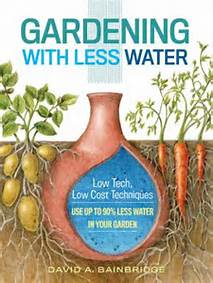 A lack of water is becoming more and more of a problem throughout the world driving up the cost of water and food. David A. Bainbridge’s book, Gardening with Less Water addresses the problem by presenting a super-efficient irrigation system that promises to increase production with less water while minimizing the time required to irrigate and weed the garden. Using lessons from the past Bainbridge has developed a system that is both low tech and low cost and can be used for any size garden from farms to containers.
A lack of water is becoming more and more of a problem throughout the world driving up the cost of water and food. David A. Bainbridge’s book, Gardening with Less Water addresses the problem by presenting a super-efficient irrigation system that promises to increase production with less water while minimizing the time required to irrigate and weed the garden. Using lessons from the past Bainbridge has developed a system that is both low tech and low cost and can be used for any size garden from farms to containers.
The text is divided into two parts. The first discusses seven simple irrigation systems that reduce water demand and help develop plants that can tolerate drought. They include buried clay pots (also called olla), porous capsules, deep pipes, wicks, porous hose, buried clay pipe and tree shelters. Each system is described in detail and directions given for making it, accompanied by drawings and photographs to enhance the presentation. The directions are easy to follow and require no special skills, although a few optional procedures may be a little challenging. The materials used are inexpensive and readily available such as unglazed clay plots, PVC pipe, and plastic buckets. Throughout Part I the author reminds the reader that different plants require different systems and that sometimes systems can be combined for the best result.
Part II is entitled “Taking It to the Next Level” and discusses the ways to get the most our of the irrigation systems that are chosen. The five chapters in this part present suggestions for water-wise gardening, rain harvesting, landscaping for water catchment, developing a plan for the garden, patio, home or farm, and the steps you can take to work for future progress in efficient water management.
Bainbridge presents a very convincing case for adopting one or more of his super-efficient irrigation systems and their simplicity and low cost make them especially appealing. The results he describes are impressive: greatly increased yields, greatly reduced water use (and cost), and huge reduction in weeds. Such results should be appealing to anyone that has gardened whether they live in areas of abundant rain or scarce rain.